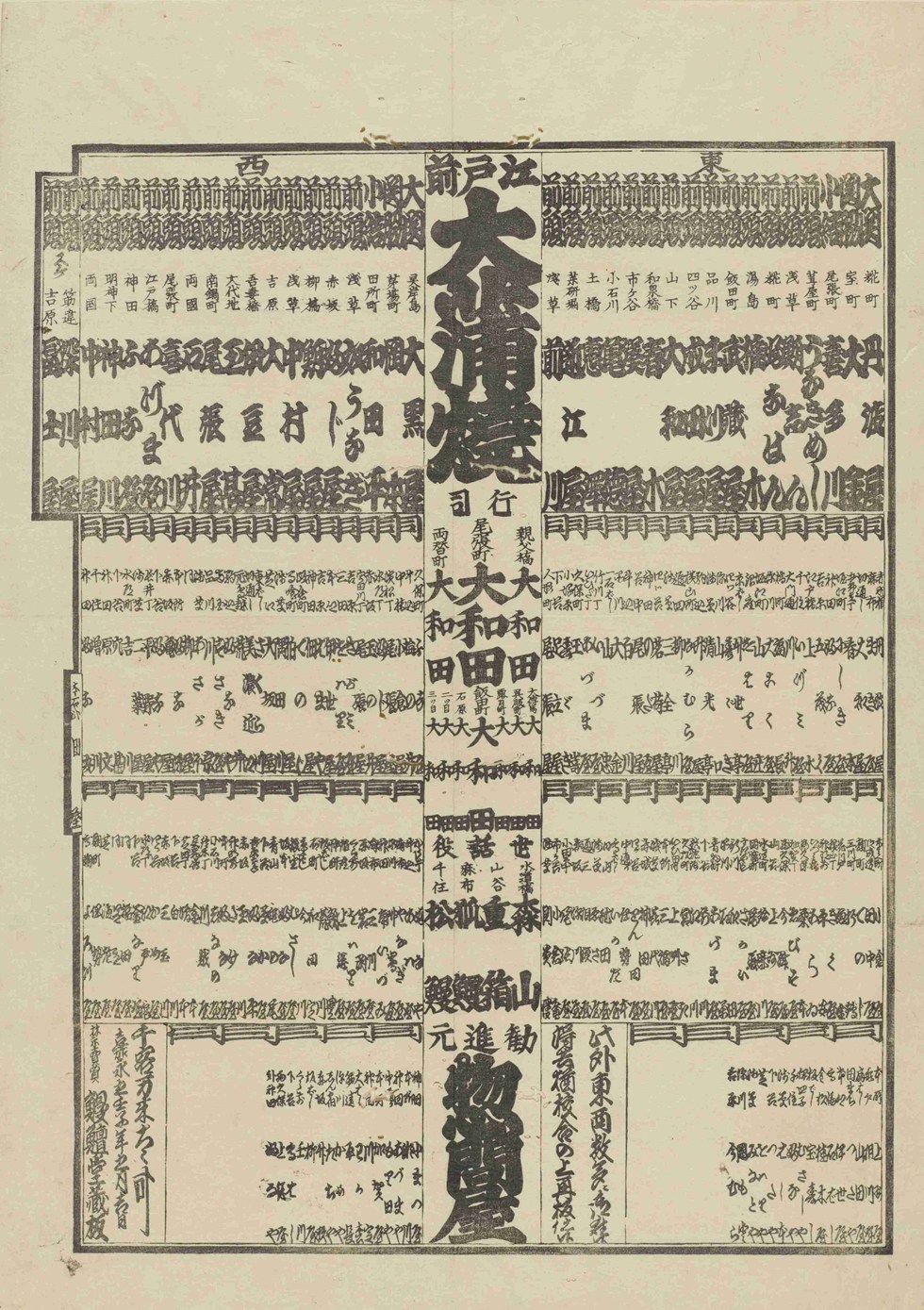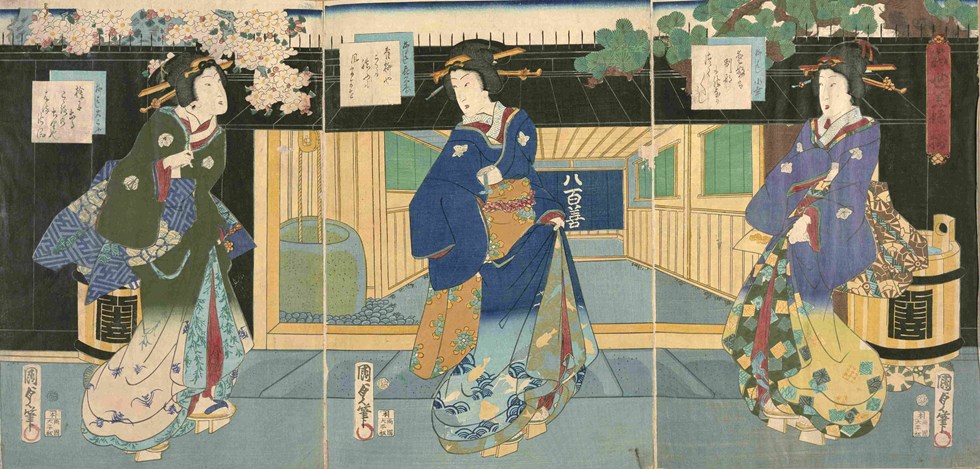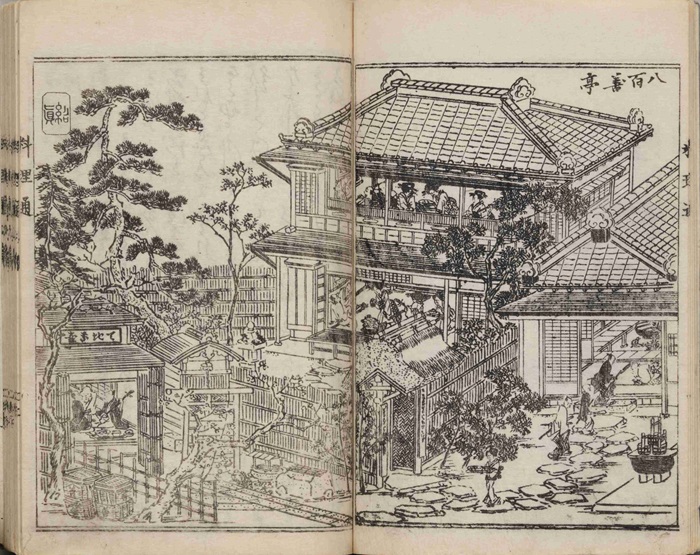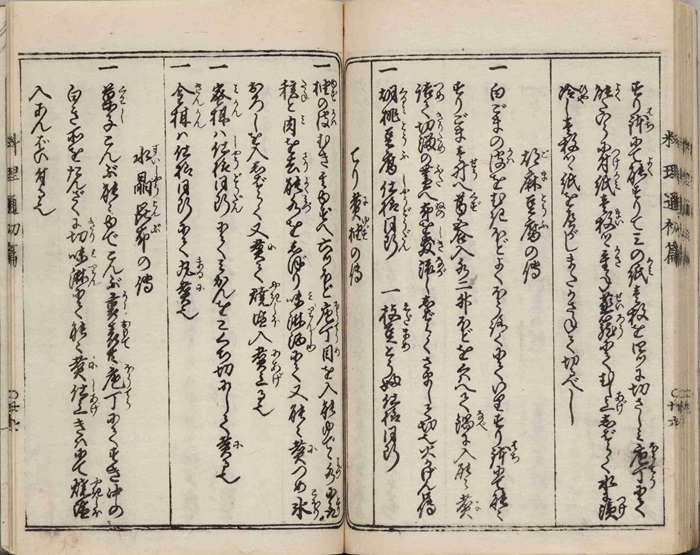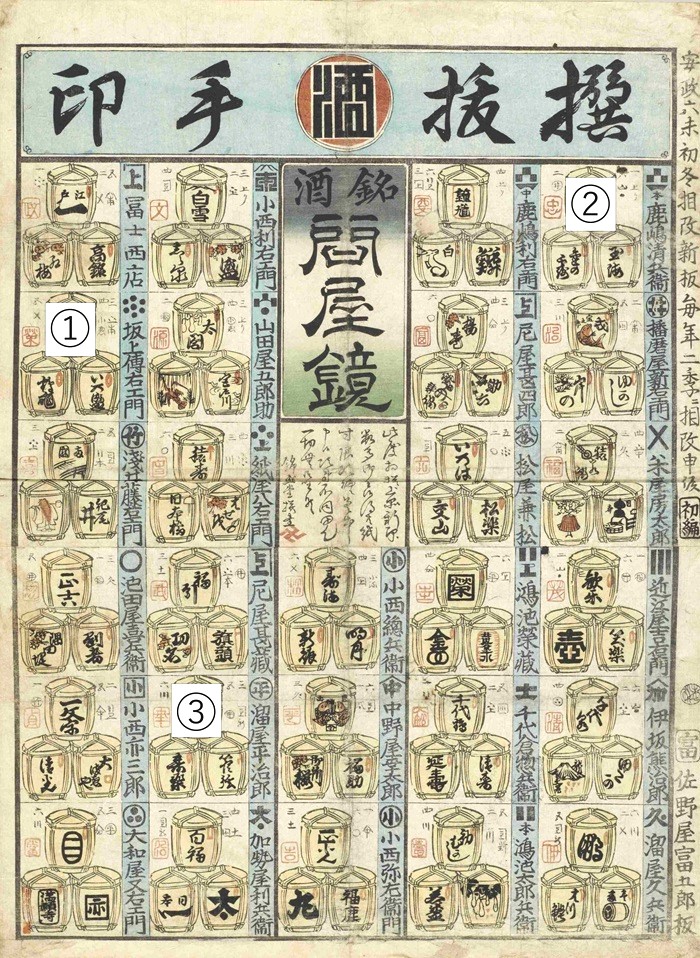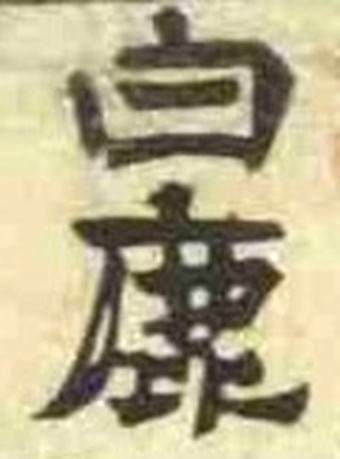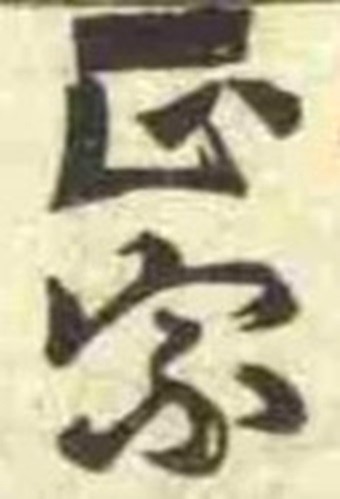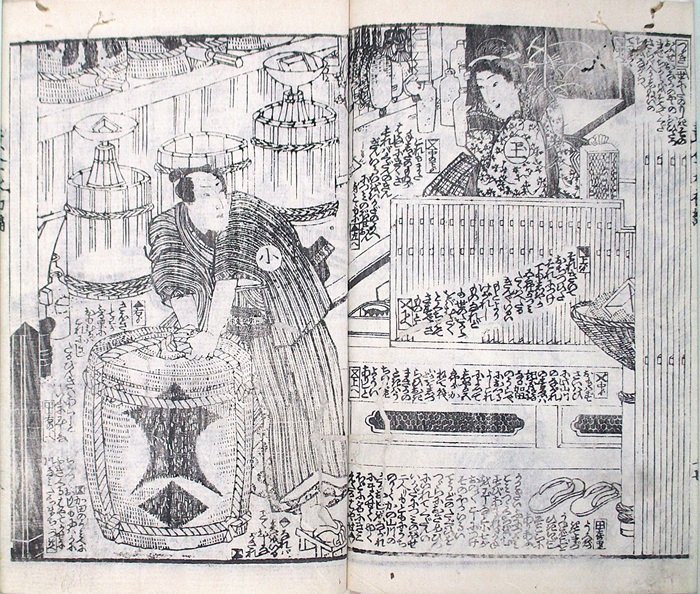
Eating
Guide to Edo's Most Famous Foods
Dining evolved into a form of culture that was enjoyed by the ordinary townsfolk of Edo. Many different types of eating and drinking establishments appeared, and numerous guides to the most famous dishes were published in forms such as guidebooks, rankings, and sugoroku board games.
- New Sugoroku Board Game Featuring Popular Dishes of Central Edo
- Tokyo Shiryō Collection 804-S4
-
In this game, players move around a board depicting some of the most popular restaurants of the time. Each cell on the board depicts a certain restaurant's facade and the signature dish. The "Kinpura" shown in the center of the board was a luxury version of deep-fried tempura cuisine in which egg yolks were added to the batter.
-

- Handbook of Eating and Drinking in Edo
- Kaga Collection 371
-
This restaurant guide has 594 entries, including some restaurants that still exist today. It also lists establishments serving produce such as loaches, sea eels, and catfish. No tempura restaurants were included in the guide at this time.
-



- Restaurant Menus: Atama Tenten Ni Kuchi Ari
- Kaga Collection hako84-1
-
This is a kibyōshi storybook written by Ota Nampo. The story features a cast of characters each representing one of the most renowned restaurants in Edo at the time, who compete with one another to produce the best dish.
-

What Dishes Were Popular Among Townsfolk?
In the late Edo period, some food vendors began to offer convenient meals similar to the fast food of today. Dishes such as buckwheat noodles, sushi, tempura, and eel sold well at street stalls and became some of the most popular Edo specialties.
- Chatting About Theater Performances in Edo
- Tokyo Shiryō Collection 577-10-6
-
This is an illustration of people eating buckwheat noodles outside the Ichimuraza theater and discussing a Kabuki play they have just seen. It shows one of the nihachi soba street stalls that sold affordable buckwheat noodle dishes.
-

- Kanegafuchi Kabuki no Furugoto
- Tokyo Shiryō Collection M138-10
-

- Column
-
Part of a series of woodblock prints depicting actors, this illustration shows a nighttime buckwheat noodle vendor. These vendors worked only at night during the colder months from fall through spring. This kind of simple stall carried on the vendor's shoulders was known as a ninaiyatai (mobile stall), while the larger, immobile type was called yataimise (shop stall).
- Sushi Restaurant Ranking
- Kaga Collection 4248
-
This is a guide to sushi restaurants in Edo presented in the style of a sumo wrestler ranking. Depicted as the referee here is Sakaiya Matsugorō of the Matsunozushi restaurant, who some say is the inventor of nigiri sushi. Others say that it was invented by Hanaya Yohei of the Yoheizushi restaurant.
-

- Storybook Collection: Far-Fetched Dialogs
- Kaga Collection hako96-2
-
Part of Santō Kyōden’s final collection of kibyōshi storybooks, this page shows vendors of new season's bonito, tempura, and broiled eel. The type of oil most commonly used for frying tempura at the time was sesame oil.
-

- Ranking of Broiled Eel Restaurants
- Kaga Collection 4239
-

Famous and Exclusive Restaurants
High-end restaurants started to appear in the late Edo period, and grew in number as time went on.
- Women Dressed in Benkei Stripes: Ataka no Matsu
- Tokyo Shiryō Collection K662-20-9
-
This title refers to both Ataka no Matsu, a piece of dance music about the warrior-monk Benkei, and Ataka Matsu ga Sushi, the name of a popular high-class sushi restaurant. Shown on the plate are pieces of nigiri made with shrimp and bluefish, as well as egg-wrapped sushi rolls.
-
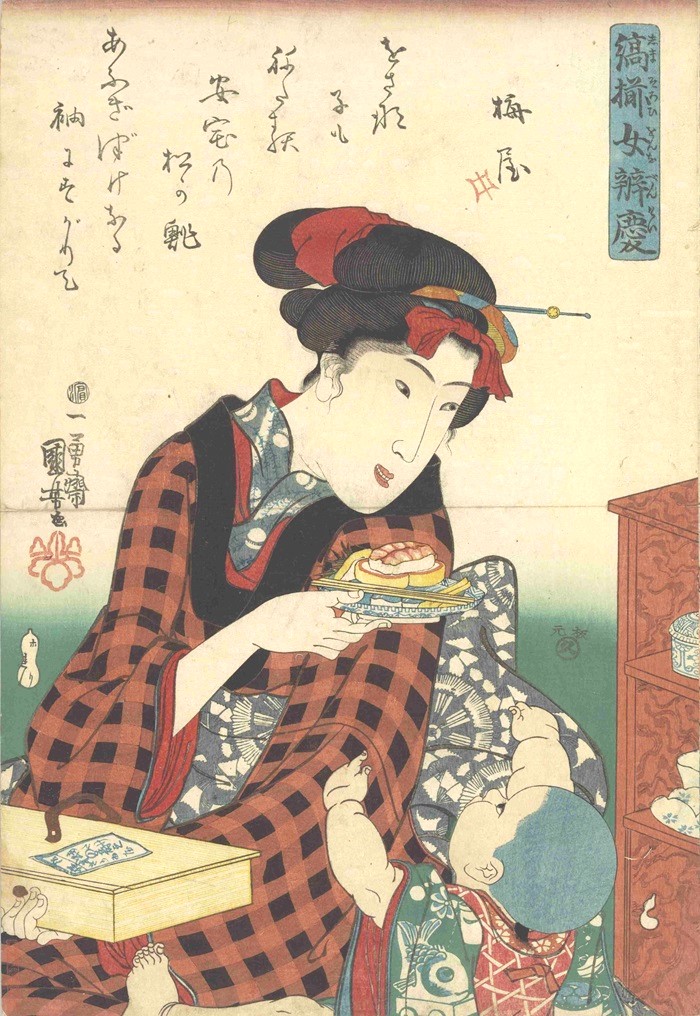
- Restaurant Ranking: New Year's Edition 1859
- Tokyo Shiryō Collection 0797-22
-
This is a ranking of highly renowned restaurants. Among the top ranks on the left side is Momokawa, which was a high-class establishment frequented by distinguished authors and artists. Momokawa vanished completely after the Meiji Restoration.
-

- Beauties of the Present Day
- Tokyo Shiryō Collection 0797-C5
-
The shop curtain of Yaozen is visible in the background of this colored woodblock print. Yaozen was known as Edo's top restaurant at the time.
-

- Popular Dishes of Edo
- Kaga Collection 3777
-
This is a collection of menus from the restaurant Yaozen. It includes lists of seasonal dishes and recipes. Distinguished figures contributed forewords, afterwords and illustrations, and the collection became a popular souvenir of Edo.
- Quiz
-
This is a ranking of sake (rice wine) including kudarizake, which came to Edo from the Kansai region. It shows barrels carrying the names of each beverage, classified by the sake merchants that sold them. Which of the following three brands belongs in the blank space on the left?
- A famous sake of the Itami/Nada region.
- A sake brewery still uses this trademark today.
- The motifs are a sword and a diamond shape.
The answer is A. The brand is Kenbishi, a long-standing brewer that today is known as Kenbishi Sake Brewing Co., Ltd. A barrel with the Kenbishi logo is also shown in the illustration of sake breweries titled Golden Waters for Good Customers. Sake from Kansai was well-known for its exceptional flavor.
- Sake Wholesalers and Their Brands
- Tokyo Shiryō Collection 883-31
-
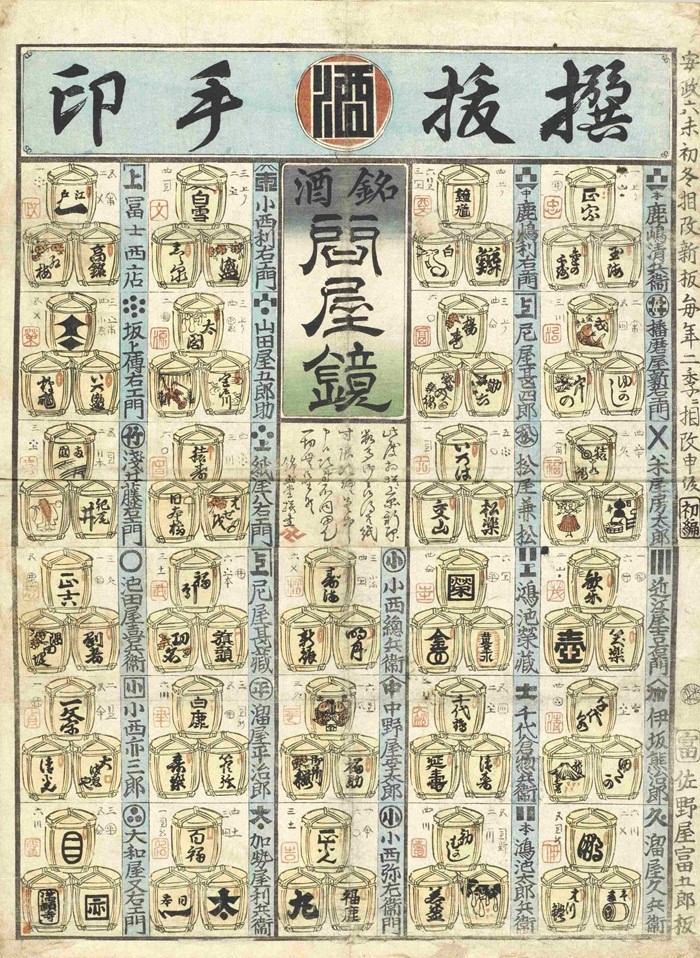
 文化財ウィーク
文化財ウィーク
